VER-SUR-MER, France (AP) — Eighty years after Christian Lamb helped rescue France from Nazi tyranny, French President Emmanuel Macron kissed her on both cheeks and pinned the nation’s highest honor to her lapel.
Lamb spent the months before D-Day alone in a tiny room in central London drawing the detailed maps that guided landing craft to the beaches of Normandy as Allied forces began their invasion of occupied France on June 6, 1944. The work was so secret she didn’t even tell her husband.
Now 103 and seated in a wheelchair, Lamb took center stage Thursday when Macron awarded her the Legion of Honor during British ceremonies marking the 80th anniversary of D-Day.
“You were, in your own way, among those figures in the shadow of D-Day,” Macron told her. “You were not there in person but you guided each step they took.”
“You have set us an example which we’ll not forget,” he added.
By the time of the Normandy landings, Lamb had been doing her part to defeat the Nazis for almost five years as member of the Women’s Royal Naval Service, known as the Wrens.
While the history of D-Day is often told through the stories of the men who fought and died on the beaches, hundreds of thousands of military women worked behind the scenes in crucial non-combat roles such as codebreakers, ship plotters, radar operators and cartographers.
The contributions of women like Lamb, radio operator Marie Scott and Pat Owtram, whose work helped crack previously unbreakable Nazi codes, have come into sharper focus as the number of living D-Day veterans dwindles. All three have been awarded the Legion of Honor as the French government offers its gratitude to those who helped liberate the country during World War II.
As D-Day approached, Lamb was assigned the task of creating charts for the landing craft crews who would deliver troops to the Normandy beaches.
Referring to huge maps of the French coast pinned to the wall of her tiny office, the young Women’s Royal Naval Service officer painstakingly created maps that highlighted every landmark to help crews get their bearings.
The maps “showed railways, roads, churches, castles, every possible feature that could be visible to an incoming invader and from every angle,” Lamb told The Associated Press in a recent interview. “It was intense and exciting work, and obviously detail was vital. It was crucial that the maps were 100% accurate.”
Lamb recalled the tension as everyone around her prepared for Operation Overlord, the long-awaited invasion of Europe that eventually ended the Nazis’ grip on the continent. Passing Prime Minister Winston Churchill on the stairs on her way to work, she worried about the pressure he was facing.
Recalling those days, her eyes glistened as she spoke about the way Churchill inspired the nation.
“He made these speeches which everybody listened to,” she said. “And I could hear him now saying, ‘We’ll fight on the beaches, fight in the hills. We’ll never surrender.’ We all felt just like that.?
Lamb’s career in the Wrens began shortly after war broke out in the summer of 1939.
One of her assignments was as a plotting officer at Portsmouth, the home of the Royal Navy. Lamb was part of a team of Wrens who used information from radar stations and coast guards to plot ship movements through the English Channel on a large flat table.
She later took on a similar role in Belfast, plotting the movements of convoys that carried supplies from North America. That included staffing her post as the news came in that a convoy escorted by her future husband’s ship, the destroyer HMS Oribi, had been attacked by a U-boat wolf pack.
Twelve of the convoy’s 43 ships were lost, but HMS Oribi made it safely to Newfoundland. The couple were married six months later in December 1943.
Lamb said she had a special resolve to help drive the Nazis out of France, particularly the centers of art and culture like Caen and Bayeux, where she had studied before the war.
“I really wanted (to do) anything that would help me to get … France back to the French,” she said. “We wanted them to belong to each other again.”
In a 2007 book about her wartime experiences, Lamb joked that she only joined the Wrens because of their tricorne hats, which she thought “splendid.”
She lost hers a long time ago.
But now she has a magnificent decoration with a bright red ribbon to replace it.
This website uses cookies so that we can provide you with the best user experience possible. Cookie information is stored in your browser and performs functions such as recognising you when you return to our website and helping our team to understand which sections of the website you find most interesting and useful.
